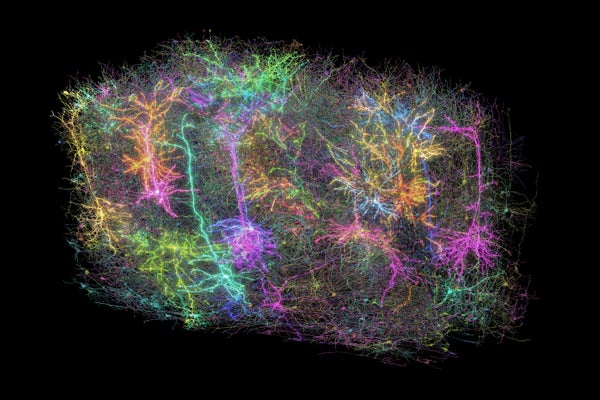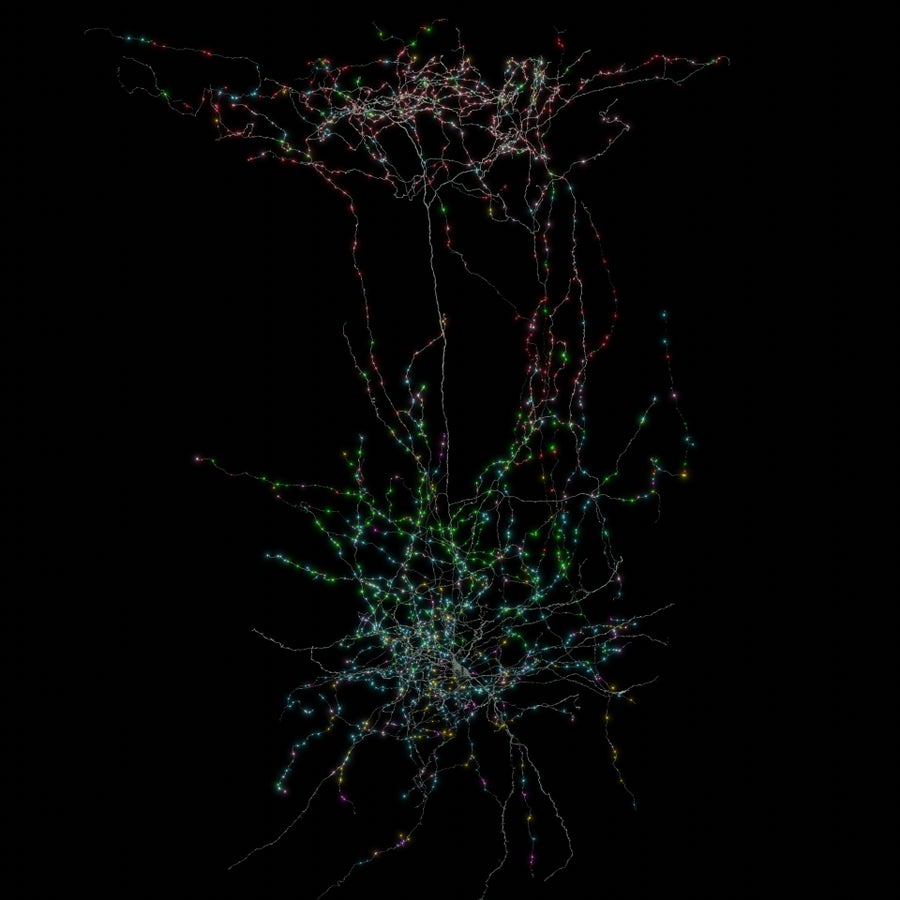Largest Mind Map Ever Exhibits Mouse Neurons in Beautiful Element
Neuroscientists have created the most important and most detailed map of a mammal’s mind in a landmark achievement

A rendering of greater than 1,000 mind cells out of the these reconstructed from evaluation of a cubic millimetre of mind tissue from a mouse.
Researchers have created the most important and most detailed wiring diagram of a mammalian mind thus far, by mapping cells in a cubic millimetre of a mouse’s mind tissue. In a landmark achievement, the diagram additionally particulars the exercise of particular person neurons on a big scale―a neuroscience first.
The high-resolution 3D map comprises greater than 200,000 mind cells, round 82,000 of that are neurons. It additionally consists of greater than 500 million of the neuronal connection factors known as synapses and greater than 4 kilometres of neuronal wiring, all present in a tiny block of tissue in a mind area concerned in imaginative and prescient. The one mind map of comparable scale is that of a cubic millimetre of human brain, which included 16,000 neurons and 150 million synapses. The brand new map additionally captured the exercise of tens of hundreds of neurons firing alerts and interacting with one another to course of visible data.
This brain-activity map, mixed with the wiring diagram, marks a milestone in connectomics, a subject that goals to point out how brains course of and set up data. Behind the huge efforts are greater than 150 researchers within the Machine Intelligence from Cortical Networks (MICrONS) undertaking, who described their work in a package deal of eight papers revealed right now in Nature and Nature Strategies. The MICrONS undertaking has made its assets accessible for the neuroscience neighborhood on-line, and different groups are already exploring them in numerous research.
On supporting science journalism
In case you’re having fun with this text, take into account supporting our award-winning journalism by subscribing. By buying a subscription you might be serving to to make sure the way forward for impactful tales concerning the discoveries and concepts shaping our world right now.
“They managed to do one thing that we haven’t achieved as a neuroscience neighborhood in principally all of our historical past, which is to have the ability to map the exercise of neurons onto the wiring on a really giant inhabitants of neurons,” says Mariela Petkova, a neuroscientist at Harvard College in Cambridge, Massachusetts, who just isn’t concerned with the undertaking. “We now have by no means seen it at this scale.”
The information “are actually stunningly lovely,” says Forrest Collman, a neuroscientist on the Allen Institute for Mind Science in Seattle, Washington, who co-authored the research. “Taking a look at it actually provides you an awe concerning the sense of complexity within the mind that may be very a lot akin to trying up on the stars of evening.”
Mouse in a matrix
To create the breakthrough map, researchers first recorded the firing of virtually 76,000 neurons within the visible cortex of a mouse because the animal watched numerous movies, together with clips from The Matrix, for 2 hours. Then they sliced up a cubic millimetre of the mouse’s mind into hundreds of tissue slices, every about one four-hundredth the width of a human hair.

Rendering of a layer 5 Martinotti cell (gray) reconstructed from a large-scale electron microscopy dataset. The output synapses (shiny spots) are color-coded by the goal cell sort. Crimson dots are synapses made onto excitatory layer 2/3 pyramidal cells and cyan dots are onto intra-telencephalic-projecting excitatory neurons in layer 5.
Clare Gamlin/Allen Institute
The scientists imaged every slice and assembled the photographs right into a 3D map. Lastly, they used synthetic intelligence and machine-learning algorithms to annotate the neurons, their branching projections and their synapses. The workforce additionally matched the neurons within the map with their recordings of mind cells in motion.
Moritz Helmstaedter, a neuroscientist on the Max Planck Institute for Mind Analysis in Frankfurt, Germany, says “the mixture of operate and construction at that scale” is unprecedented. It’s “a really spectacular endeavour and success”.
Fireplace collectively, wire collectively
The work yielded insights into the essential guidelines that form neural circuits within the mouse mind. For instance, the authors discovered that neurons within the cortex that reply to comparable varieties of visible characteristic—equivalent to sure shapes or instructions of motion—usually type extra connections with each other, regardless of how far aside they’re, than they do with neurons focusing on a unique sort of characteristic.
The outcomes add a brand new wrinkle to a long-held idea in neuroscience, says Collman—particularly, that “neurons that fireside collectively wire collectively.” Earlier research have examined this idea solely in restricted numbers of neurons and synapses. The present examine reveals that “there’s a range [to] how a lot this rule is utilized throughout all of the totally different parts of cortex,” he provides.
The MICrONS researchers hope that their knowledge set can assist to disclose numerous options and processes within the mind. “There are all types of cortical areas that we perceive at totally different ranges of element and in numerous methods. And I feel that is actually solely the start of relating construction and performance,” says Clay Reid, a neurobiologist on the Allen Institute and a co-author of the MICrONS papers.
Helmstaedter says researchers can use the wiring maps to check how the mind shops and recollects visible reminiscences, equivalent to “our recollection of the final party or of our grandparents.” These are “the large open questions concerning the mammalian cortex which can be nonetheless very elementary,” he provides.
The newly revealed map covers round 0.2% of the mouse’s mind, however the MICrONS workforce will likely be testing the applied sciences to map the animal’s complete mind, says Nuno Maçarico da Costa, a neuroanatomist on the Allen Institute and one other co-author of the MICrONS papers.
This text is reproduced with permission and was first revealed on April 9, 2025.


